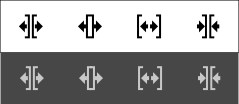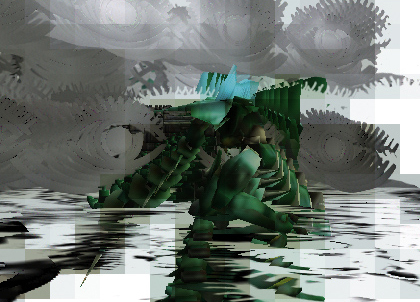20
08/23
21:34
Contribution to kdenlive
Two years ago I contributed to the free video editor kdenlive with a series of icons for advanced trimming tools.

https://invent.kde.org/frameworks/breeze-icons/-/merge_requests/108
20
08/23
21:34
Two years ago I contributed to the free video editor kdenlive with a series of icons for advanced trimming tools.

https://invent.kde.org/frameworks/breeze-icons/-/merge_requests/108
19
02/13
14:42
One variation of my (self-)portrait, (auto-)retrato: 100 fragmentos, variaciones 1 y 2, has been selected for presentation in the Media Art show at the coming XII Festival Internacional de la Imagen in Manizales, Colombia.
Work’s statement in Spanish:
La interrupción de la máquina facial solo es posible a través de la fragmentación interna del tiempo y el espacio del cuadro.
Este (auto-)retrato es una aglomeración, en un mismo cuadro, de imágenes grabadas con un celular en diferentes momentos y lugares. El objetivo es diluir mi propia imagen a través su fragmentación. Variación 1 y 2 se componen de 100 fragmentos de grabaciones de vídeo. Cada vídeo ha sido grabado por una persona diferente en momentos y lugares diferentes usando una cámara de celular. En cada variación los 100 vídeos son reproducidos simultáneamente y son ubicados en el cuadro de forma aleatoria hasta llenarlo completamente. El resultado es un vídeo compuesto de una serie consecutiva de tiras verticales de vídeo una al lado de la otra. En estas dos variaciones se juntan 100 “”yos” separados en el tiempo y el espacio.”
A complete description of this work in English is here: self-portrait
13
10/11
09:42
DIY encompasses the following propositions:
02
02/11
02:54
ap-pro-pri-ate, adj., v.
1. -adj. particularly suitable; fitting; compatible: remarks appropriate to the occasion.
2. -v.t. to set apart for a specific purpose or use: to appropriate funds for an environmental study.
3. to take to or for oneself; take possession of.
4. to take without permission; expropriate.
[1515-25; < LL approopriātus, ptp of appropriāre to make one’s own = L ap– ap-‘ + –propriāre, v. der. of propious one’s own].
ap-pro-pri-a-tion, n.
1. the act of appropriating.
2. anything appropriated for a special purpose, esp. money authorized to be paid from the public treasury.
[1325-75; ME (< MF) >LL]
Abbreviation key LL: late Latin; ME: middle English; MF middle French.
Source: Random House Webster’s College Dictionary. McGRAW-HILL Edition, 1991.
18
11/10
22:02
SIGRADI 2010 announcement here
Machinima Fictions: A DIY practice to produce animated movies from Videogames
Ricardo Cedeño Montaña
Building: Edificio W.
Room: Classroom 101
Date: 2010-11-18 04:20 PM – 04:40 PM
Last modified: 2010-11-03
Abstract
ABSTRACT
The mixture of playing videogames and producing movies has produced a new kind of moving image, a hybrid that, in the underground realm of videogames, has silently lured thousands to enter its territories. In the late 1990s, devoted players started to use videogame software for movie production. Their activity molded a narrative medium called ‘machinima’. Two recent productions are discussed to describe the various facets of this phenomenon in order to present the features that make up machinima and how it is relevant to popular culture.
KEYWORDS: machinima, videogames, hybrid, real-time, do-it-yourself (DIY).
Update (28.feb.2011)
23
11/09
21:28
Hi,
last month I guided a seminar about Machinima in the master programme in interactive design and creation at the Universidad de Caldas in Manizales, Colombia. It was a pleasure to me to be there exchanging and sharing ideas about DIY, popular culture, and the moving image.
In the seminar a small group of master’s students got engaged in an intensive three days study about machinima. We discussed concepts such as hybrid media, real-time, and DIY. Finally, they produced what can be called, as far as I’m informed, the first machinima pieces in a university in Colombia. Their results vary from sound works to mashups of popular songs. These works can be read and watched here: third cohort and second cohort.
and here:
10
09/09
21:31
HI, machinima goes on finding its way into the academia. My little contribution has been added to the Leonardo’s thesis abstract service (LABS). Now in Leonardo On-line, my work can be consulted for anyone interested in the topic. My thesis is identified by the node 284, here its link.

Movement under thousand eyes
As any scientific work, mine is open and free, therefore, today I share and publish an electronic version to anyone who wants to read the entire document, here the pdf. I hope to receive soon your critical comments.
18
05/09
19:38
HI,
one part of my recent thesis discusses fan and amateur video productions in the context of machinima and DIY media. Star Wars holds a large fan community all around the word, only comparable to trekkies, that has made it to achieve its status as cult film. These are very active communities whose members usually get involved in organising festivals and conventions, and in publishing fanzines and other forms of DIY media.
Fans, independent of the cult media, appropriate the original media content to extend its diegetic world. These activities can be read as either participatory or resistant towards the media. The story lines, characters, and aesthetics of the media cult are unfolded in order to fill gaps, or to accommodate them to personal, political, and social issues. In all cases, fan’s productions are deviations of the cult media (film, TV series, video game, and pop bands) that the producers do not support officially, but that in many cases they encourage as long as these productions increase the popularity of their cultural text.
The access to nearly inexpensive tools for media production has brought a proliferation of these fan’s (di,-sub-, and per-) versions with a decent and even high quality. Fanzines, fanart, music videos, mash-ups, disguises, parallel narrations, mods, machinimas, and online forums are part of a huge realm in media production that currently is garnering as much attention as the original productions in the Internet.
Recently, I found via Wired the following videos by Mike Horn, an enthusiast of Star Wars. His DIY productions combine the amateurish style of camcorder video with CG animations. He places the universe of Star Wars in contact with San Francisco and in one of the videos in narrative collision with Star Trek.
14
10/08
18:31
HI,
Starflyer a short clip I did with some other fellows is being shown, this time in the Freimarkt Bremen web-site. There, under Freimarkt Videos is the link to Starflyer and to Our youth another clip done last winter term. In the picture you can see where to click.
For more information about starflyer and the youtube version please visit here.
Many thanks for any comment!
P.D. Freimarkt web-site has been updated from now on the videos are available here
02
10/08
16:52
Hi, we tend to think that mixing media is a new trend but looking back in history sometimes it surprises us with examples that show the opposite. A question I got recently is if mixing, remixing and hybrid media already exist before algorithmic revolution then What is so special about current digital mixing?
Again in the Internet archive, I found this old animation-video which is a mix of text, animation and real footage in a unique package, everything . In “Now you’re talking” (1927) a poor and mistreated telephone has to visit a doctor, a dream its owner would not forget. Check it out!